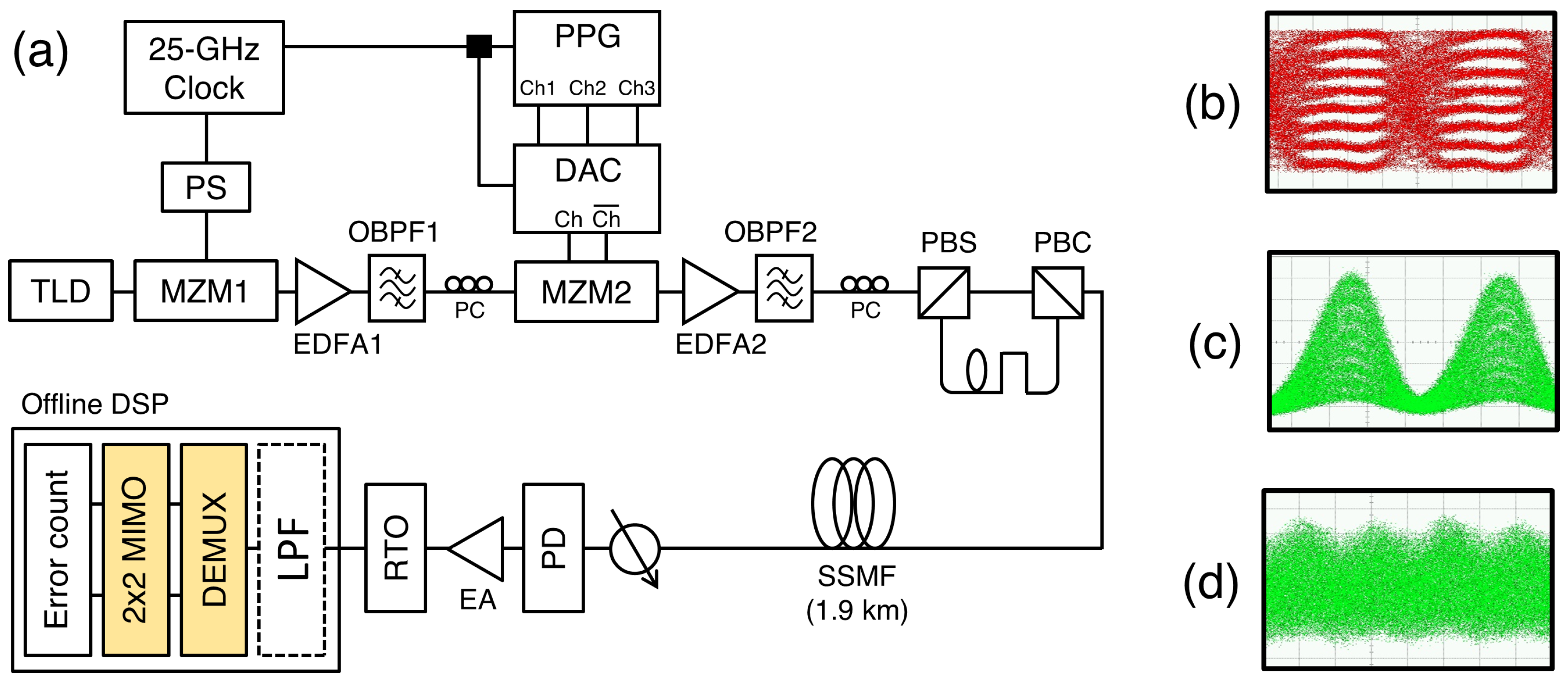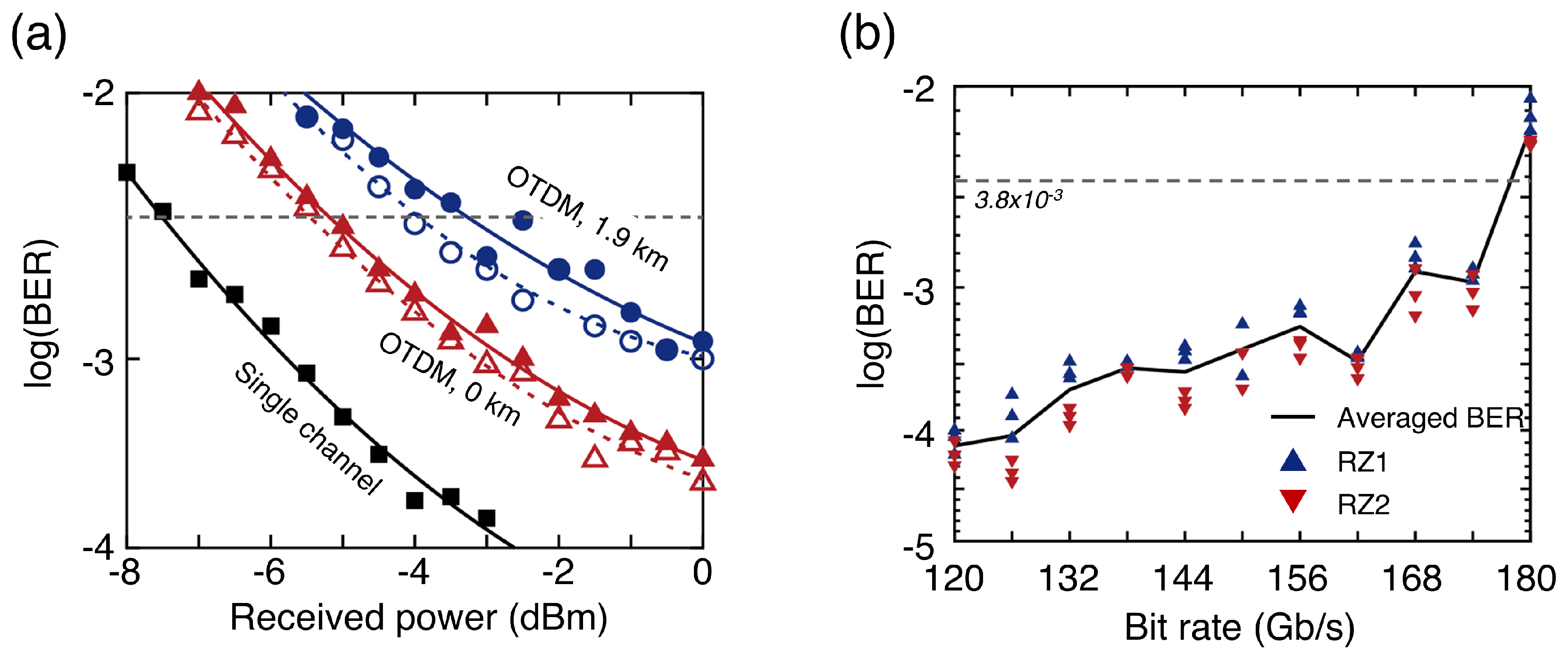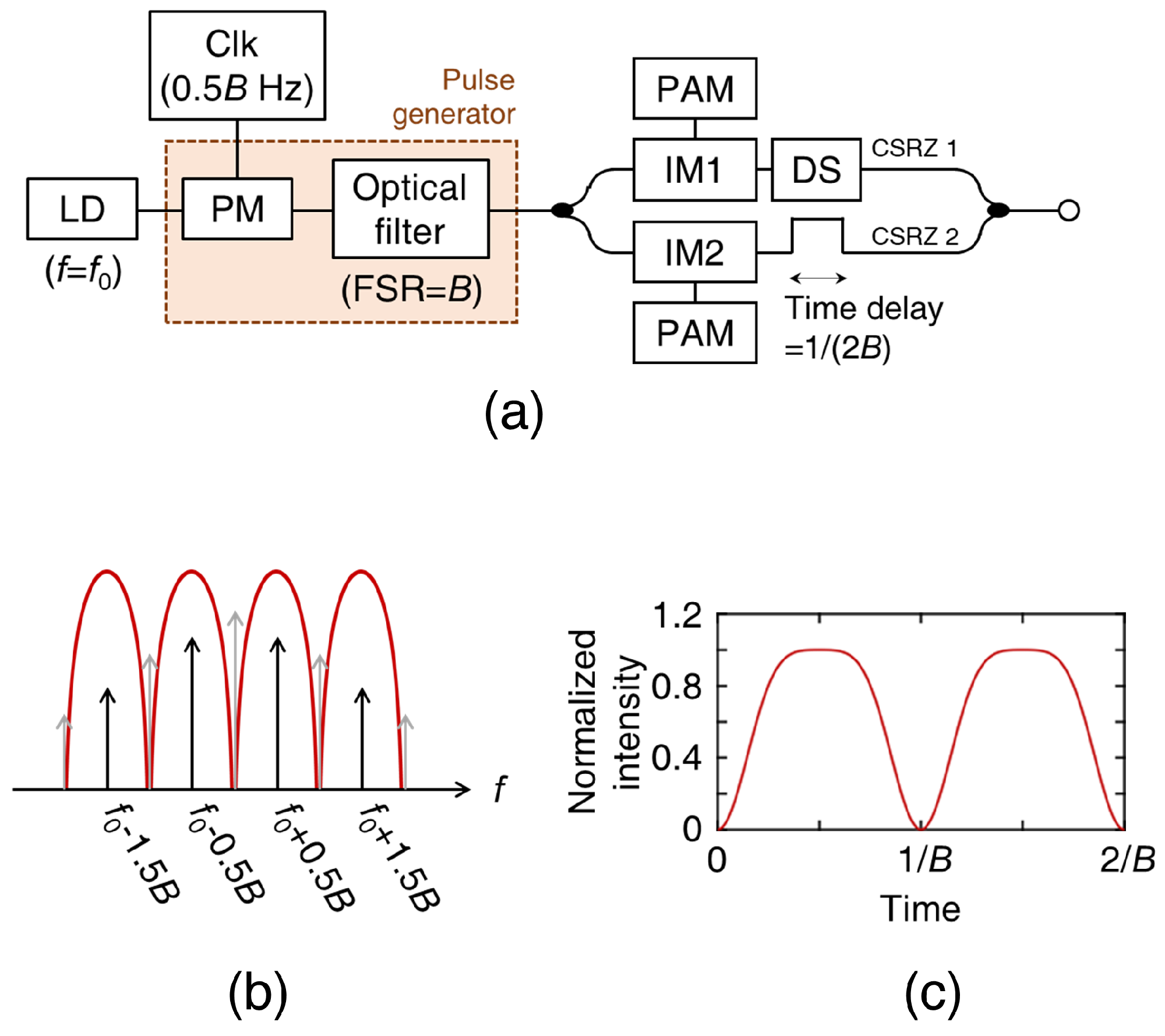Two-Channel OTDM System for Data-Center Interconnects: A Review
Abstract
1. Introduction
2. Two-Channel OTDM System with Constant-Phase Pulse
2.1. System Architecture
2.2. OTDM System Using the Symbol-Spaced MIMO Equalizer
2.2.1. Transmission Experiments
2.2.2. Roles of the MIMO Equalizer
2.3. OTDM System Using a Multilayer Equalizer
Experimental Results Obtained Using a Multilayer Equalizer
3. Two-Channel OTDM System with Phase-Alternating Pulse
3.1. Phase-Alternating Pulse Generation
3.2. Experimental Results
4. Discussion
5. Conclusions
Author Contributions
Funding
Institutional Review Board Statement
Informed Consent Statement
Data Availability Statement
Conflicts of Interest
References
- Zhong, K.; Zhou, X.; Huo, J.; Yu, C.; Lu, C.; Lau, A.P.T. Digital Signal Processing for Short-Reach Optical Communications: A Review of Current Technologies and Future Trends. J. Light. Technol. 2018, 36, 377–400. [Google Scholar] [CrossRef]
- Zhou, X.; Urata, R.; Liu, H. Beyond 1Tb/s Datacenter Interconnect Technology: Challenges and Solutions (Invited). In Proceedings of the Optical Fiber Communication Conference (OFC) 2019, San Diego, CA, USA, 3 March 2019; p. Tu2F.5. [Google Scholar] [CrossRef]
- Xie, C.; Zhang, B. Scaling Optical Interconnects for Hyperscale Data Center Networks. Proc. IEEE 2022, 110, 1699–1713. [Google Scholar] [CrossRef]
- Li, W.; Zhang, M.; Zeng, Y.; Chen, Y.; Chen, J.; Li, Y.; Tang, M. SOA Enabled Self-Homodyne Coherent Bidirectional Transmission for Metro-Datacenter Interconnects. J. Light. Technol. 2023, 41, 2601–2612. [Google Scholar] [CrossRef]
- 2023 Ethernet Alliance Roadmap. 2023. Available online: www.ethernetalliance.com (accessed on 12 May 2023).
- Available online: http://www.ieee802.org/3/bs/public/index.html (accessed on 12 May 2023).
- Winzer, P.J.; Neilson, D.T. From Scaling Disparities to Integrated Parallelism: A Decathlon for a Decade. J. Light. Technol. 2017, 35, 1099–1115. [Google Scholar] [CrossRef]
- Cisco Annual Internet Report (2018–2023) White Paper. Available online: https://www.cisco.com/c/en/us/solutions/collateral/executive-perspectives/annual-internet-report/white-paper-c11-741490.html (accessed on 12 May 2023).
- Ozolins, O.; Joharifar, M.; Salgals, T.; Louchet, H.; Schatz, R.; Gruen, M.; Dippon, T.; Kruger, B.; Pittala, F.; Che, D.; et al. Optical Amplification-Free High Baudrate Links for Intra-Data Center Communications. J. Light. Technol. 2023, 41, 1200–1206. [Google Scholar] [CrossRef]
- Uchiyama, A.; Okuda, S.; Hokama, Y.; Shirao, M.; Abe, K.; Yamatoya, T. 225 Gb/s PAM4 2 km and 10 km Transmission of EMLs with Hybrid Waveguide Structure for 800GbE and 1.6TbE Transceivers. In Proceedings of the Optical Fiber Communication Conference (OFC) 2023, San Diego, CA, USA, 5–9 March 2023; p. M2D.2. [Google Scholar]
- Hu, Q.; Chagnon, M.; Schuh, K.; Buchali, F.; Bülow, H. IM/DD Beyond Bandwidth Limitation for Data Center Optical Interconnects. J. Light. Technol. 2019, 37, 4940–4946. [Google Scholar] [CrossRef]
- Shi, J.; Zhang, J.; Chi, N.; Yu, J. Comparison of 100G PAM-8, CAP-64 and DFT-S OFDM with a bandwidth-limited direct-detection receiver. Opt. Express 2017, 25, 32254–32262. [Google Scholar] [CrossRef]
- Masuda, A.; Yamamoto, S.; Taniguchi, H.; Nakamura, M.; Kisaka, Y. 255-Gbps PAM-8 Transmission under 20-GHz Bandwidth Limitation using NL-MLSE Based on Volterra Filter. In Proceedings of the 2019 Optical Fiber Communications Conference and Exhibition (OFC), San Diego, CA, USA, 3–7 March 2019; pp. 1–3. [Google Scholar]
- Yu, Y.; Che, Y.; Bo, T.; Kim, D.; Kim, H. Reduced-state MLSE for an IM/DD system using PAM modulation. Opt. Express 2020, 28, 38505–38515. [Google Scholar] [CrossRef]
- Hossain, M.S.B.; Rahman, T.; Stojanović, N.; Rosales, R.; Wettlin, T.; Calabrò, S.; Wei, J.; Xie, C.; Pachnicke, S. Transmission beyond 200 Gbit/s with IM/DD System for Campus and Intra-Datacenter Network Applications. IEEE Photonics Technol. Lett. 2021, 33, 263–266. [Google Scholar] [CrossRef]
- Wang, C.; Wang, K.; Tan, Y.; Ding, J.; Sang, B.; Zhou, W.; Yu, J. Beyond 200 Gbit/s/λ VSB PS-PAM8 Employing Joint Neural Network Equalization at C-band. IEEE Photonics Technol. Lett. 2022, 34, 941–944. [Google Scholar] [CrossRef]
- Zhang, J.; Wang, K.; Wei, Y.; Zhao, L.; Zhou, W.; Xiao, J.; Liu, B.; Xin, X.; Zhao, F.; Dong, Z.; et al. 280 Gb/s IM/DD PS-PAM-8 Transmission over 10 km SSMF at O-Band for Optical Interconnects. In Proceedings of the 2020 Optical Fiber Communications Conference and Exhibition (OFC), San Diego, CA, USA, 8–12 March 2020; pp. 1–3. [Google Scholar]
- Wang, K.; Zhang, J.; Zhao, M.; Zhou, W.; Zhao, L.; Yu, J. High-Speed PS-PAM8 Transmission in a Four-Lane IM/DD System Using SOA at O-Band for 800 G DCI. IEEE Photonics Technol. Lett. 2020, 32, 293–296. [Google Scholar] [CrossRef]
- Verbist, J.; Vanhoecke, M.; Lillieholm, M.; Srinivasan, S.A.; Heyn, P.D.; Campenhout, J.V.; Galili, M.; Oxenløwe, L.K.; Yin, X.; Bauwelinck, J.; et al. 4:1 Silicon Photonic Serializer for Data Center Interconnects Demonstrating 104 Gbaud OOK and PAM4 Transmission. J. Light. Technol. 2019, 37, 1498–1503. [Google Scholar] [CrossRef]
- Weber, H.G.; Ludwig, R.; Ferber, S.; Schmidt-Langhorst, C.; Kroh, M.; Marembert, V.; Boerner, C.; Schubert, C. Ultrahigh-Speed OTDM-Transmission Technology. J. Light. Technol. 2006, 24, 4616–4627. [Google Scholar] [CrossRef]
- Bae, S.; Park, J.; Han, S.; Kim, B.G.; Kim, M.; Yu, K.; Chung, Y.C. A Cost-Effective 2-Channel OTDM System Implemented With Sinusoidally Modulated Light Source. IEEE Access 2020, 8, 157504–157509. [Google Scholar] [CrossRef]
- Haus, H. Mode-locking of lasers. IEEE J. Sel. Top. Quantum Electron. 2000, 6, 1173–1185. [Google Scholar] [CrossRef]
- Kim, J.; Ludwig, F.; Felber, M.; Kärtner, F.X. Long-term stable microwave signal extraction from mode-locked lasers. Opt. Express 2007, 15, 8951–8959. [Google Scholar] [CrossRef]
- Peccianti, M.; Pasquazi, A.; Park, Y.; Little, B.E.; Chu, S.T.; Moss, D.; Morandotti, R. Demonstration of a stable ultrafast laser based on a nonlinear microcavity. Nat. Commun. 2012, 3, 1–6. [Google Scholar] [CrossRef]
- Sakamoto, T.; Kawanishi, T.; Tsuchiya, M. 10 GHz, 2.4 ps pulse generation using a single-stage dual-drive Mach-Zehnder modulator. Opt. Lett. 2008, 33, 890–892. [Google Scholar] [CrossRef]
- Hu, H.; Mulvad, H.C.H.; Peucheret, C.; Galili, M.; Clausen, A.; Jeppesen, P.; Oxenløwe, L.K. 10 GHz pulse source for 640 Gbit/s OTDM based on phase modulator and self-phase modulation. Opt. Express 2011, 19, B343–B349. [Google Scholar] [CrossRef]
- Cheng, Q.; Bahadori, M.; Glick, M.; Rumley, S.; Bergman, K. Recent advances in optical technologies for data centers: A review. Optica 2018, 5, 1354–1370. [Google Scholar] [CrossRef]
- Lange, S.; Wolf, S.; Lutz, J.; Altenhain, L.; Schmid, R.; Kaiser, R.; Schell, M.; Koos, C.; Randel, S. 100 GBd Intensity Modulation and Direct Detection With an InP-Based Monolithic DFB Laser Mach–Zehnder Modulator. J. Light. Technol. 2018, 36, 97–102. [Google Scholar] [CrossRef]
- Bae, S.; Lee, Y. Multilayer equalizer for 2-channel OTDM-PAM-8 transmission system. Opt. Commun. 2023, 537, 129420. [Google Scholar] [CrossRef]
- Bae, S. Dispersion-tolerant 200-Gb/s OTDM-PAM4 system using a simple phase-alternating pulse generator. Opt. Commun. 2021, 501, 127383. [Google Scholar] [CrossRef]
- Park, J.; Han, S.; Chung, Y.C.; Yu, K. 300-Gb/s/λ IM/DD Transmission Using Integrated SiP OTDM Transmitter. IEEE Photonics Technol. Lett. 2023, 35, 529–532. [Google Scholar] [CrossRef]
- Sacher, W.D.; Barwicz, T.; Taylor, B.J.F.; Poon, J.K.S. Polarization rotator-splitters in standard active silicon photonics platforms. Opt. Express 2014, 22, 3777–3786. [Google Scholar] [CrossRef]
- He, M.; Xu, M.; Ren, Y.; Jian, J.; Ruan, Z.; Xu, Y.; Gao, S.; Sun, S.; Wen, X.; Zhou, L.; et al. High-performance hybrid silicon and lithium niobate Mach–Zehnder modulators for 100 Gbit/s−1 and beyond. Nat. Photonics 2019, 13, 359–364. [Google Scholar] [CrossRef]
- Kim, M.S.; Kim, B.G.; Chung, Y.C. 300-Gb/s Transmission Using OTDM System Implemented With Sinusoidally Modulated Input Light Source. IEEE Photonics Technol. Lett. 2022, 34, 745–748. [Google Scholar] [CrossRef]
- Zheng, X.; Chang, E.; Amberg, P.; Shubin, I.; Lexau, J.; Liu, F.; Thacker, H.; Djordjevic, S.S.; Lin, S.; Luo, Y.; et al. A high-speed, tunable silicon photonic ring modulator integrated with ultra-efficient active wavelength control. Opt. Express 2014, 22, 12628–12633. [Google Scholar] [CrossRef]
- Sato, K.; Toba, H. Reduction of mode partition noise by using semiconductor optical amplifiers. IEEE J. Sel. Top. Quantum Electron. 2001, 7, 328–333. [Google Scholar] [CrossRef]
- Che, Y.; Kim, H. Cost-Effective C-Band 50-Gb/s PON Implemented by Using a 2-Bit DAC and Linear Electrical Equalizer. IEEE Photonics Technol. Lett. 2023, 35, 215–218. [Google Scholar] [CrossRef]
- Shim, H.K.; Kim, H.; Chung, Y.C. 20-Gb/s Polar RZ 4-PAM Transmission Over 20-km SSMF Using RSOA and Direct Detection. IEEE Photonics Technol. Lett. 2015, 27, 1116–1119. [Google Scholar] [CrossRef]
- Li, H.; Sheng, Y.; Li, Y.; Rothenberg, J. Phased-only sampled fiber Bragg gratings for high-channel-count chromatic dispersion compensation. J. Light. Technol. 2003, 21, 2074–2083. [Google Scholar] [CrossRef]














Disclaimer/Publisher’s Note: The statements, opinions and data contained in all publications are solely those of the individual author(s) and contributor(s) and not of MDPI and/or the editor(s). MDPI and/or the editor(s) disclaim responsibility for any injury to people or property resulting from any ideas, methods, instructions or products referred to in the content. |
© 2023 by the authors. Licensee MDPI, Basel, Switzerland. This article is an open access article distributed under the terms and conditions of the Creative Commons Attribution (CC BY) license (https://creativecommons.org/licenses/by/4.0/).
Share and Cite
Bae, S.; Kim, H.-J. Two-Channel OTDM System for Data-Center Interconnects: A Review. Sensors 2023, 23, 5908. https://doi.org/10.3390/s23135908
Bae S, Kim H-J. Two-Channel OTDM System for Data-Center Interconnects: A Review. Sensors. 2023; 23(13):5908. https://doi.org/10.3390/s23135908
Chicago/Turabian StyleBae, Sunghyun, and Hyeon-June Kim. 2023. "Two-Channel OTDM System for Data-Center Interconnects: A Review" Sensors 23, no. 13: 5908. https://doi.org/10.3390/s23135908
APA StyleBae, S., & Kim, H.-J. (2023). Two-Channel OTDM System for Data-Center Interconnects: A Review. Sensors, 23(13), 5908. https://doi.org/10.3390/s23135908






